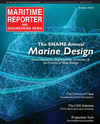
Page 31: of Maritime Reporter Magazine (October 2018)
Marine Design Annual
Read this page in Pdf, Flash or Html5 edition of October 2018 Maritime Reporter Magazine
are inherently additional CAPEX and the test bed, you’re comfortable, but the Injection) engine two-stroke propulsion Jones. “Essentially it is our call to action
OPEX on the ship itself. “With LNG proof in the pudding is when you install engines are designed to provide ship to reduce emissions and establish natu- you have a lot more sensors, you have it on a ship. What I think is signi? cant owners and operators with a solution ral gases as the fuels of choice in global a lot more safety equipment, a lot more about this project is from the boardroom with two-stroke technology without the shipping.” MAN Energy Solution has alarms, a lot more IOs … our barge for to the engine room, there was great sup- greenhouse emissions such as methane also developed an ME-LGI (-Liquid Gas example has 2500 IOs … in a 2200 cu. port. And I don’t think projects like this slip. “The development of the ME-GI Injection) dual-fuel engine that expands m. barge,” said Keller. But over the pro- can work without that support.” engine is one element of what we call the company’s dual-fuel portfolio, en- jected life of the ship, Keller said the MAN Energy Solutions ME-GI (-Gas the ‘Maritime Energy Transition’,” said abling the use of more sustainable fuels case for LNG was strong and clear.
EXPERIENCE ON THE SHIPS ‘Isla Bella’ and ‘Perla del Caribe’ are 3,100-TEU sister ships that serve the route between Jacksonville, Fla., and
San Juan, Puerto Rico, propelled by the ? rst ME-GI dual-fuel engines produced by MAN Energy Solutions.
“I don’t think most ship owners under- stand that this LNG technology has been running as long as it has in a purely com- mercial environment,” said Keller. “The
LNG fueled ME-GI engine represents
TOTE’s commitment to environmental stewardship. Importantly, LNG as a fuel eliminates SOx and particulate matter, signi? cantly reduces NOx and –increas- ingly importantly – contributes to the re- duction of greenhouse gases. This gives us the ability to move forward aggres- sively in terms of air quality which is especially important in the pristine areas of the Caribbean and Florida where our vessels operate.”
Keller said that the industry has two environmental problems: air quality and decarbonization. Regarding air quality, his answer is simple: “we’ve been work- ing on it for decades, and today we have the answer: Lique? ed Natural Gas.”
Decarbonization is not so simple.
“LNG will contribute to this by 15- 25%, and that’s good, that’s a step toward the IMO targets of 2030 and 2050,” said
Keller. “Does it get us there? No. But it gets us going in the right direction. We have to be very careful that we don’t al- low one problem to supersede the other.
We have to do both, we have to clean up the air; on the other side there is an issue with global warming, and we have to ad- dress that.” “We’ve had three years of very suc- cessful operation of a full LNG ship, and not just the main engines but the auxiliaries too. The ships haven’t missed a stroke, they’ve been week in and out of Puerto Rico, on schedule and they are clean.”
THE POWERPLANTS
Not only were the ships groundbreak- ing, the MAN ME-GI engines installed were the ? rst in the world, so MAN En- ergy Solutions naturally had a vested interest to ensure success, as Wayne
Jones, Chief Sales Of? cer and Member of the Executive Board, MAN Energy
Solutions, explained. “In the lab and in www.marinelink.com 31
MR #10 (26-33).indd 31 MR #10 (26-33).indd 31 10/4/2018 3:56:47 PM10/4/2018 3:56:47 PM

 30
30

 32
32
